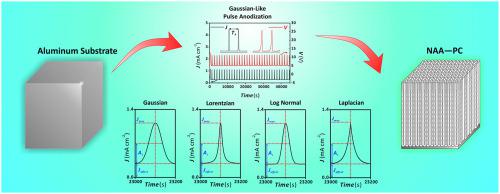Microporous and Mesoporous Materials ( IF 5.2 ) Pub Date : 2020-11-18 , DOI: 10.1016/j.micromeso.2020.110770 Lina Liu , Siew Yee Lim , Cheryl Suwen Law , Laura K. Acosta , Bo Jin , Andrew D. Abell , Lluis F. Marsal , Gang Ni , Abel Santos

|
A new class of nanoporous anodic alumina photonic crystals (NAA–PCs) are optically engineered by four distinct forms of Gaussian-like pulse anodization (GLPA) – Gaussian, Lorentzian, logarithmic normal, and Laplacian. NAA–PCs produced by GLPA under current density control conditions show well-resolved, spectrally tunable photonic stopbands (PSBs), the features of which – central wavelength, full width at half maximum, intensity, and quality factor – can be precisely tuned across the UV–visible spectrum by the input Gaussian-like current density pulses. Effects of type, width, and period of Gaussian-like current density pulses on the structural and optical properties of NAA–PCs are systematically assessed. Comprehensive electrochemical, structural, and optical characterizations allow us to elucidate the interplay of input GLPA profile and structural features in determining forbidden light propagation within these NAA–PCs. Sensitivity of these PC structures toward changes in their effective medium are determined by quantifying spectral shifts in their characteristic PSB upon infiltration of their nanoporous structure with analytical solutions of alcohol mixtures with varying refractive index, from 1.362 to 1.383 RIU. It is found that, at fixed anodization period, NAA–PCs produced by Laplacian current density pulses achieve the highest sensitivity (105 ± 4 nm RIU−1) and, for a given type of GLPA, NAA–PCs produced with longer anodization period achieve higher sensitivity (123 ± 10 nm RIU−1 for NAA–PCs fabricated by Gaussian pulses with a 1400 s-period). Our advances provide exciting new opportunities for future developments of high-quality NAA–PCs with broad applicability across various photonic technologies, including optical sensing, photocatalysis, lasing, and optical encoding.
中文翻译:

纳米多孔光子晶体的高斯样脉冲阳极氧化光学工程
一类新型的纳米多孔阳极氧化铝光子晶体(NAA–PC)由高斯脉冲,阳极氧化,对数正态和拉普拉斯算子的四种不同形式的高斯脉冲阳极氧化(GLPA)光学工程化。GLPA在电流密度控制条件下生产的NAA–PC显示了分辨良好的,光谱可调的光子阻带(PSB),其特征–中心波长,半峰全宽,强度和品质因数–可以在整个波长范围内精确调整。输入高斯样电流密度脉冲产生的紫外可见光谱。系统评估了类高斯电流密度脉冲的类型,宽度和周期对NAA-PCs结构和光学性质的影响。综合电化学,结构,光学特性使我们能够阐明输入GLPA轮廓和结构特征在确定这些NAA–PC中禁止的光传播方面的相互作用。这些PC结构对有效介质变化的敏感性是通过用折射率从1.362至1.383 RIU的醇混合物的分析溶液渗透其纳米孔结构后,量化其特征PSB的光谱位移来确定的。结果发现,在固定的阳极氧化期间,由拉普拉斯电流密度脉冲产生的NAA–PC可获得最高的灵敏度(105±4 nm RIU 这些PC结构对有效介质变化的敏感性是通过用折射率从1.362至1.383 RIU的醇混合物的分析溶液渗透其纳米孔结构后,量化其特征PSB的光谱位移来确定的。结果发现,在固定的阳极氧化期间,由拉普拉斯电流密度脉冲产生的NAA–PC可获得最高的灵敏度(105±4 nm RIU 这些PC结构对有效介质变化的敏感性是通过用折射率从1.362至1.383 RIU的醇混合物的分析溶液渗透其纳米孔结构后,量化其特征PSB的光谱位移来确定的。结果发现,在固定的阳极氧化期间,由拉普拉斯电流密度脉冲产生的NAA–PC可获得最高的灵敏度(105±4 nm RIU-1),并且对于给定类型的GLPA而言,阳极氧化周期更长的NAA-PC可获得更高的灵敏度(对于由1400 s周期的高斯脉冲制造的NAA-PC而言,其灵敏度为123±10 nm RIU -1)。我们的进步为高品质NAA-PC的未来发展提供了令人振奋的新机会,这些产品将广泛应用于各种光子技术,包括光学传感,光催化,激光和光学编码。


























 京公网安备 11010802027423号
京公网安备 11010802027423号